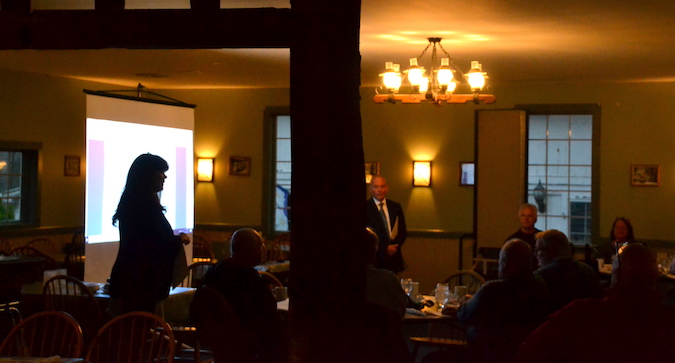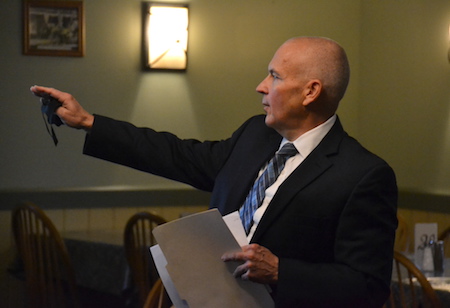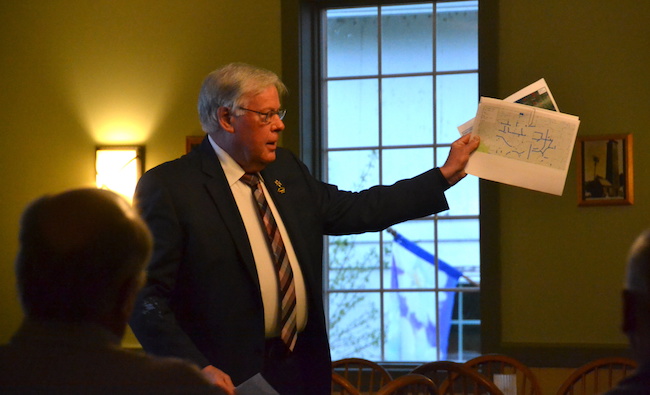Orleans officials say time is right to push for county-wide high-speed internet
$4.1 million would cover gaps in county, give residents option besides Spectrum

Photos by Tom Rivers: Orleans County Legislature Chairwoman Lynne Johnson speaks to about 25 officials from the county, local towns and the five school districts during a meeting at Tillman’s Village Inn to discuss how to fund broadband internet in Orleans County.
GAINES – A top priority for Orleans County officials the past decade has been bringing high-speed internet to all properties in the county.
Cost has been a barrier to getting the project done.
But now is the time to bring the service to all county residents, County Legislature Chairwoman Lynne Johnson said on Thursday evening in a meeting with county, town and school district leaders.
“We all need to buy into this,” Johnson told about 25 of the officials during a meeting at Tillman’s Village Inn. “You’re all getting American Rescue funds. So let’s do this together.”
With millions of dollars coming to the county, towns and school districts from the federal government through the American Rescue Plan, the $4.1 million price tag is now manageable, she said.

Jack Welch, the county’s chief administrative officer, said a cooperative effort will make the project affordable to all the municipalities, while meeting a critical need in the county.
The American Rescue Plan will bring $7.8 million to the county, with half expected soon and the other half in a year. The 10 towns in the county will share $4,430,000 with some of that to go the four villages. The federal government hasn’t released how much the villages we get.
The villages are all 100 percent fully covered with high-speed internet. Outside the villages, there are 1,351 addresses that don’t have a chance to hook into the service. There are about 22,000 properties in the entire county.
The five school district collectively will receive $12.5 million in federal funds. However, the districts will be expected to use most of those funds to help students catch up in lost learning during the pandemic, said Mark Kruzynski, Medina’s district superintendent.
The districts today are to receive guidance on how the funds are to be spent, and then have 30 days to submit a plan for how to use the funds. Kruzynski said Medina doesn’t want to make a mistake, using the funds outside the rules and then have to pay the federal government back.
Johnson said the purpose on Thursday’s meeting was to start the conversation among the county, towns and schools in how to fill the gaps in high-speed internet. She said everyone needs to follow the spending guidelines, but she expects there will be flexibility from the federal government.
“This meeting is to get the ball rolling,” she said.
Some of the town supervisors said they still don’t know for sure what their towns are getting in the American Rescue Plan because some of the allotments approved for the towns need to go to villages within those town borders.
John Belson, Yates town supervisor, said the private developer should take on the costs of building out the system.
If that happened, the costs to residents would be exorbitant, Johnson said. Plus, she said, one of the purposes in the funding from the federal government was to address the high-speed internet gaps, which put many students at an extreme disadvantage with remote learning. Many jobs also shifted to home and people couldn’t do them without high-speed internet.
Legislator John DeFillipps said the service is needed to keep the county competitive in keeping and attracting residents. He noted one family from out-of-state was going to build a house in Clarendon but backed out when the site didn’t have internet access.
“The pandemic has shown there is really a deficiency in the entire county,” Johnson said.
The address points currently without access to the internet include: Albion, 74 units; Barre, 302 units; Carlton, 35 units; Clarendon, 57 units; Gaines, 39 units; Kendall, 16 units; Murray, 41 units; Ridgeway, 287 units; Shelby, 206 units; and Yates, 294 units.
Breaking that out in the five school districts the gaps include: Albion, 407 units; Holley, 70 units; Kendall, 30 units; Lyndonville, 385 units; and Medina, 409 units.

David Godfrey, a Niagara County legislator, has worked with Lynne Johnson in the Niagara Orleans Regional Alliance the past decade to try to bring the service to the two counties. Godfrey said the two-county partnership has paid off in getting the attention of RTO Wireless, a company that provided high-speed internet throughout Maine and Vermont.
The local officials have been working for 12 years now to bring high-speed internet to swaths of the county and other isolated spots that don’t have access to the service. The officials also want better overall service throughout the county and some competition for Spectrum.
The efforts have hit stumbling blocks with funding. But all of the leg work, documenting 1,351 addresses without access to high-speed internet, puts the county in a good position now that millions of dollars are available from the federal government through the American Rescue Plan.
A vendor also has stepped forward for the first time to work on the project, not only in Orleans but in neighboring Niagara County. The two counties formed the Niagara-Orleans Regional Alliance and bringing high-speed internet throughout the two counties has been a priority of the alliance the past decade.
RTO Wireless, based in Framingham, Massachusetts, has already brought broadband to the entire states of Maine and Vermont. It could bring the service to Orleans County for $4.1 million. That includes the 1,351 properties without access and opportunities for the other 20,000 property owners to have high-speed internet from a company besides Spectrum.
RTO builds and operates networks with traditional infrastructure such as towers, rooftops, grain silos and utility poles. The company also deploys AeroSite, which resemble blimps filled with helium.
David Godfrey, a Niagara County legislator, has teamed with Johnson in the Niagara-Orleans alliance to address the service shortfalls in the two counties. He said the two-county partnership is an advantage for Orleans and Niagara in finding a vendor and could pay off with additional government funding.
‘Twelve years ago it was the number one priority and it remains the number one priority. And now we have the funds. This is a necessary utility as much as water, sewer and electric in this day and age.’ – Lynne Johnson
Orleans is pursuing an additional federal grant and also a member-item award through Congressman Chris Jacobs. If that money comes through, the towns and schools would be asked to contribute less to the project.
She said the county is willing to put $2 million towards the effort. That covers 61 percent of the $3.2 million to put in the infrastructure and the net start-up costs to serve all the properties throughout the county.
However, there is additional $878,150 to be borne by the 1,351 properties, at $650 a unit, to hook into the service.
As the rules are known in spending the federal funds, Godfrey said he expects the two counties can use several different pots of money from the government to fund the project, including the hook-in costs to the 1,351 properties in Orleans without any service right now.
After many dead ends in trying to address the internet gaps in Orleans County, Johnson said she is optimistic the issue will soon be resolved.
The local officials will continue to discuss the project, and study the guidelines on spending the federal money.
“Twelve years ago it was the number one priority and it remains the number one priority,” she said. “And now we have the funds. This is a necessary utility as much as water, sewer and electric in this day and age.”





































































